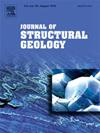晚中生代下扬子地区陆内变形与古应力场:对华南构造演化的启示
IF 2.9
2区 地球科学
Q2 GEOSCIENCES, MULTIDISCIPLINARY
引用次数: 0
摘要
中国南方晚中生代陆内变形与欧亚板块东缘俯冲碰撞作用密切相关,为大陆演化提供了丰富的线索。下扬子地区位于华南东北部,晚中生代经历了复杂的陆内变形,是了解东亚构造演化的关键区域。通过对代表性露头的详细野外考察和区域断裂断滑资料的构造分析,重建了下扬子地区晚中生代的变形序列和古应力场。研究结果表明,下扬子地区经历了晚侏罗世至晚白垩世早期的三阶段构造演化,以收缩和伸展交替的构造事件为特征。第一阶段为晚侏罗世至早白垩世早期的收缩变形,受北西-东西收缩应力控制,形成郯庐断裂左旋走滑运动、楚河断裂和长江断裂右旋走滑运动和茅山断裂自顶向西逆冲运动。这种收缩变形被认为与古太平洋板块向西低角度俯冲到欧亚板块之下有关。第二阶段是早白垩世北西-东西伸展,与一系列高角度正断层有关,与古太平洋板块的回滚有关。第三阶段是早白垩世晚期至晚白垩世早期的另一次收缩变形,导致了近南北向收缩控制的构造反转。这种收缩导致了区域断层的左旋走滑运动,并与一组共轭走滑断层有关。鄂霍托斯克地块与欧亚板块之间的斜向碰撞是这次收缩事件的地球动力学驱动因素。构造对比分析表明,晚侏罗世至早白垩世早期,下扬子地区与华南其他地区具有明显的变形模式。在相同的北西-东南收缩作用下,下扬子地区主要表现为沿主要断裂的走滑运动,而华南其他地区则表现为北东向-南西向的逆冲褶皱变形。这种差异可能与下扬子地区独特的构造位置和原有的基底断裂有关。由于刚性克拉通(即华北克拉通)的阻碍,地壳物质沿原有断裂向东北方向横向挤压,形成了晚侏罗世至早白垩世早期的连续收缩。本文章由计算机程序翻译,如有差异,请以英文原文为准。
Intracontinental deformation and paleo-stress fields of the lower yangtze region during the late Mesozoic: implications for the tectonic evolution of South China
The late Mesozoic intracontinental deformation in South China preserves rich insights into continental evolution, with close link to subduction and collision processes along the eastern margin of the Eurasian Plate. The Lower Yangtze Region, located in the northeastern part of South China, underwent complex intracontinental deformation during the late Mesozoic, making it a key area for understanding the tectonic evolution of East Asia. Through detailed field investigation of representative outcrops and structural analysis of fault-slip data from the regional faults, this study reconstructs the late Mesozoic deformation sequence and paleo-stress fields in the Lower Yangtze Region. Our new data, combined with published results, suggest that the Lower Yangtze Region experienced a three-stage tectonic evolution from the Late Jurassic to early Late Cretaceous, characterized by alternating contractional and extensional tectonic events. The first stage, contractional deformation from the Late Jurassic to early Early Cretaceous, was controlled by NW-SE contractional stress, generating sinistral strike-slip motion along the Tan-Lu Fault, the dextral strike-slip motion along the Chuhe Fault and Yangtze River Fault, and top-to-west thrusting of the Maoshan Fault. This contractional deformation is interpreted as being related to the westward low-angle subduction of the Paleo-Pacific Plate beneath the Eurasian Plate. The second stage is NW-SE extension during the Early Cretaceous, associated with a series of high-angle normal faults, which is correlated with the rollback of the Paleo-Pacific Plate. The third stage is another episode of contractional deformation that resulted in a tectonic inversion controlled by nearly N-S contraction during late Early Cretaceous to early Late Cretaceous. This contraction led to the sinistral strike-slip motion of the regional faults and was associated with a set of conjugate strike-slip faults. The oblique collision between the Okhotomorsk Block and the Eurasian Plate serves as the geodynamic driver for this contraction event. Comparative structural analysis reveals distinct deformation patterns between the Lower Yangtze Region and other areas of South China during the Late Jurassic to early Early Cretaceous. Under the same NW-SE contraction, the Lower Yangtze Region exhibited predominant strike-slip motion along the major faults, whereas other areas of South China developed NNE-SSW-striking thrust-and-fold deformation. This disparity is possibly caused by the unique tectonic position and pre-existing basement faults of the Lower Yangtze Region. Due to the obstruction of the rigid craton (i.e., the North China Craton), the crustal materials underwent lateral extrusion towards the northeast along the pre-existing faults, accommodating the continuous contraction that occurred during the Late Jurassic to early Early Cretaceous.
求助全文
通过发布文献求助,成功后即可免费获取论文全文。
去求助
来源期刊

Journal of Structural Geology
地学-地球科学综合
CiteScore
6.00
自引率
19.40%
发文量
192
审稿时长
15.7 weeks
期刊介绍:
The Journal of Structural Geology publishes process-oriented investigations about structural geology using appropriate combinations of analog and digital field data, seismic reflection data, satellite-derived data, geometric analysis, kinematic analysis, laboratory experiments, computer visualizations, and analogue or numerical modelling on all scales. Contributions are encouraged to draw perspectives from rheology, rock mechanics, geophysics,metamorphism, sedimentology, petroleum geology, economic geology, geodynamics, planetary geology, tectonics and neotectonics to provide a more powerful understanding of deformation processes and systems. Given the visual nature of the discipline, supplementary materials that portray the data and analysis in 3-D or quasi 3-D manners, including the use of videos, and/or graphical abstracts can significantly strengthen the impact of contributions.
 求助内容:
求助内容: 应助结果提醒方式:
应助结果提醒方式:


